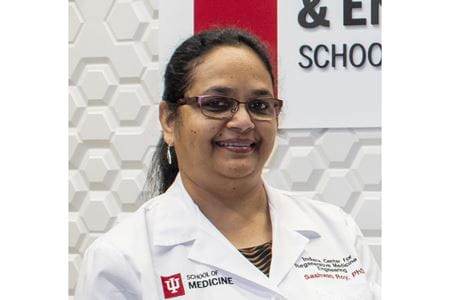Recently Indiana University School of Medicine’s faculty member and professor of surgery, Sashwati Roy, PhD, was awarded the Medical Technology Enterprise Consortium (MTEC) Prototype Acceleration Award. This award grants Roy $1.8 million in research funding for the next three years. These funds allow her to continue research on electroceutical technology that helps combat biofilm infractions in wounds.
Researchers at IU School of Medicine are the first to study the practice of using an electric field-based dressing to treat biofilms rather than antibiotics. They discovered the dressing is not only successful in fighting the bacteria on its own, but when combined with other medications, can make them even more effective. This discovery has the potential to create significant changes in the way physicians treat patients with antibiotic resistant bacterial infections. The dressing can also help prevent new biofilm infections from forming in the future. The dressing electrochemically self-generates 1 volt of electricity upon contact with body fluids such as wound fluid or blood, which is not enough to hurt or electrocute the patient.
Roy has been conducting electroceutical research at the laboratories of the Indiana Center for Regenerative Medicine and Engineering, along with Chandan Sen, PhD the J. Stanley Battersby chair professor of surgery, and director of the Indiana Center for Regenerative Medicine and Engineering. Their research has led to the development of a dressing that uses an electric field to disrupt biofilm infection and these findings have been published in the high-impact journal, “Annals of Surgery.”
The Medical Technology Enterprise Consortium (MTEC) is a 501(c)(3) biomedical technology consortium collaborating with the U.S. Army Medical Research and Development Command that works with the Department of Defense to help servicemembers suffering from injuries. MTEC supports the accelerated development of revolutionary medical solutions enhancing wound healing, so they can return wounded servicemembers and civilians back to fully functioning lives.
This award will help drive the electroceutical research into a clinical setting.
“It will play a major role in taking this product out of the preclinical stage, where we did an animal model experiment,” said Roy. “Now we can move to a clinical setting where we can start doing clinical studies and gather clinical data.”
This type of research is referred to as phase two. This is where a treatment, drug, or in this case a medical device, is administered to a group of patients to capture as much data as possible and move the research forward to phase three.
“We have to show the Federal Drug Administration that the dressings are safe, so the whole point of this proposal is for us to generate enough data to satisfy them and be allowed to take this new product to patients,” Roy said.
This research can end up helping many in the Indianapolis area and throughout Indiana. It will give a new treatment to patients suffering from chronic wounds infected by antibiotic resistant bacteria or biofilm.
As the Director of Clinical Research for the Comprehensive Wound Care Center at IU Methodist Hospital, Roy can now bring her research to patients. This gives them access to these new treatments and technologies before the general public.
“Soon we will be opening a study to a specific group of patients,” said Roy. “Thanks to the Compressive Wound Center we will give some patients the opportunity to try new treatments and technologies firsthand and provide an opportunity to improve their health before it becomes available to the public.”
Roy explained that she hopes the funding will achieve two goals. The first and most difficult is to gain understanding of how electrical fields affect the healing process. Her team strives to gain fundamental understanding of the mechanistic aspects of these electrical fields.
Roy’s second goal is to use all new scientific and academic knowledge from the new study and apply it to the clinical study in hopes of obtaining positive results. Her team can then move the project to the next level of development and bring a new technology to market